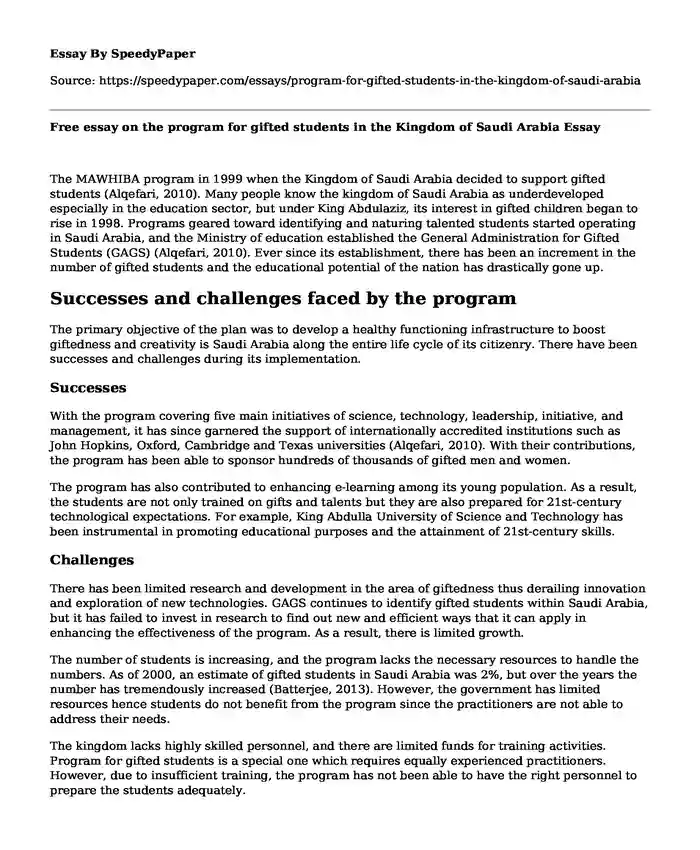
| Type of paper: | Essay |
| Categories: | Learning Asia Case study Policy analysis |
| Pages: | 3 |
| Wordcount: | 594 words |
The MAWHIBA program in 1999 when the Kingdom of Saudi Arabia decided to support gifted students (Alqefari, 2010). Many people know the kingdom of Saudi Arabia as underdeveloped especially in the education sector, but under King Abdulaziz, its interest in gifted children began to rise in 1998. Programs geared toward identifying and naturing talented students started operating in Saudi Arabia, and the Ministry of education established the General Administration for Gifted Students (GAGS) (Alqefari, 2010). Ever since its establishment, there has been an increment in the number of gifted students and the educational potential of the nation has drastically gone up.
Successes and challenges faced by the program
The primary objective of the plan was to develop a healthy functioning infrastructure to boost giftedness and creativity is Saudi Arabia along the entire life cycle of its citizenry. There have been successes and challenges during its implementation.
Successes
With the program covering five main initiatives of science, technology, leadership, initiative, and management, it has since garnered the support of internationally accredited institutions such as John Hopkins, Oxford, Cambridge and Texas universities (Alqefari, 2010). With their contributions, the program has been able to sponsor hundreds of thousands of gifted men and women.
The program has also contributed to enhancing e-learning among its young population. As a result, the students are not only trained on gifts and talents but they are also prepared for 21st-century technological expectations. For example, King Abdulla University of Science and Technology has been instrumental in promoting educational purposes and the attainment of 21st-century skills.
Challenges
There has been limited research and development in the area of giftedness thus derailing innovation and exploration of new technologies. GAGS continues to identify gifted students within Saudi Arabia, but it has failed to invest in research to find out new and efficient ways that it can apply in enhancing the effectiveness of the program. As a result, there is limited growth.
The number of students is increasing, and the program lacks the necessary resources to handle the numbers. As of 2000, an estimate of gifted students in Saudi Arabia was 2%, but over the years the number has tremendously increased (Batterjee, 2013). However, the government has limited resources hence students do not benefit from the program since the practitioners are not able to address their needs.
The kingdom lacks highly skilled personnel, and there are limited funds for training activities. Program for gifted students is a special one which requires equally experienced practitioners. However, due to insufficient training, the program has not been able to have the right personnel to prepare the students adequately.
Statistics
The initial plan of the program was to follow a five-year implementation plan as shown below. The differences in the columns indicate the three phases of implementation. The following table shows the target number of students that various program initiatives should have across the five-year phase.
| Low | Medium | High | |
| MAWHIBA school partnership | 4,500 | 6,600 | 9,000 |
| MAWHIBA enrichment program | 3,000 | 5,000 | 8,000 |
| MAWHIBA leadership and scholarship program | 1,000 | 2,000 | 3,000 |
| Total | 8,500 | 13,600 | 20,000 |
Approximately 280,000 people will benefit from the program either directly or indirectly (Mawhiba Strategic Plan 2007). The chart shows the level of influence as of the first five years of implementation.
The data assumes that the average Saudi family size is 5.6. It also incorporates the number of Saudi students at MAWHIBA-partnered schools.
References
Alqefari, A. (2010). A study of programs for gifted students in the Kingdom of Saudi Arabia (Doctoral dissertation, School of Social Sciences Ph.D. Theses).
Batterjee, A. A. (2013). The relationship between SES and giftedness in Saudi Arabia.Mankind Quarterly, 53(3), 3-52.
Presentation of Mawhiba Strategic Plan. (2007, June). Fostering Giftedness And Creativity and Supporting Innovation.
Cite this page
Free essay on the program for gifted students in the Kingdom of Saudi Arabia. (2022, Oct 28). Retrieved from https://speedypaper.com/essays/program-for-gifted-students-in-the-kingdom-of-saudi-arabia
Request Removal
If you are the original author of this essay and no longer wish to have it published on the SpeedyPaper website, please click below to request its removal:
- Ethnography Essay Example
- Communication Essay Example for Students
- Economics Essay Example: Loanable Funds and Money Creation in Banks
- Free Essay on the Economic Impact Of Cybercrime: At $600 Billion and Counting
- Research Proposal Sample on Early Intensive Intervention for Children with ASD
- Free Essay Example: Business Application Project
- Essay Sample on Off-Off-White
Popular categories




